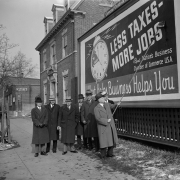There are a few professions that do not lend themselves to producing Poetic Justice Warriors. Either because they reflect human life more than transform it, or they do not appeal to individualism. While romantic artists and fiction writers have the ability to reflect human ideals, modern art denies reality. Politicians and religionists appeal to collectivism, and professional journalists, a rare breed, do their best work when reporting objectively on the events of the day.
Even that is nearly impossible, a neutral journalist has to filter information to fit the reporting medium. While Sherlock Holmes advises “It is a capital mistake to theorize before one has data,” even this is flawed. The search for data implies a theory to pursue. Perhaps the most knowledgeable, eloquent, and persistent critic of postmodern journalism is George Orwell who said that “If liberty means anything at all, it means the right to tell people what they do not want to hear.”
Poetic Justice Warrior Garet Garrett told the statists what they didn’t want to hear. He is that singular journalist who was steadfast in the defense of personal liberty. He wrote about peaceful human progress with searing language. As economist Ludwig von Mises relates,”His keen penetration and his forceful, direct language are unsurpassed by an author.”
The Political Economist
As Garrett reported in his 1949 American Affairs article Laissez-Faire, state socialists claimed there is no harmony between public and private interests. With freedom there would be serious inequalities in the distribution of wealth, and freedom’s materialism and success needed to be thwarted. Otherwise, there would be social catastrophe and mass unemployment. The socialists Garrett reported on were spewing this nonsense around the year 1800. Of course this was before freedom’s mechanized farm equipment, chronometers, electricity, steam engines, and mass production.
All economic and political thought in Europe was basically pessimistic. Nobody could imagine that in the next few generations, under laissez faire capitalism, consumable wealth would be so prodigiously multiplied that the luxuries of the rich in one generation would become the necessary satisfactions of the poor in the next.
Garrett wrote that the elimination of poverty was a uniquely American idea. Americans made the ideas of economist Jean-Baptiste Say work – wages are paid out of production, wages and profits can rise together, and rising production creates capital. In fact, he quoted Scottish Enlightenment philosopher Adam Ferguson who wrote (years before Adam Smith), “Nations stumble upon establishments which are indeed the results of human action, but not the result of human design.” Or as Garrett clarifies,
You may take that to express the doctrine of economic laissez faire, but the true meaning goes far beyond economics and belongs to the philosophy of individualism. The point is that the spirit of laissez faire had already brought into the world religious liberty and freedom of enterprise, and that the foundations of what now may be called laissez faire capitalism had already been laid before the words were familiar.
For Garrett, the great adversaries of political and economic freedom in the premodern world (before the Age of Reason) were the church and the state – “Radicalism was the sword of liberty.” In our postmodern era (ingloriously christened by World War I), Garrett lamented that “laissez faire, which was radical, is reactionary. The wheel has gone all the way around.”
The Journalist
As a 20 year old, in 1898, Garrett began his journalistic career as a writer and eventually covered politics for various publications including the Cleveland Recorder (Chicago) and the Washington Times. From there he became a financial writer for the New York Sun, the New York Times, and the Wall Street Journal. By 1922, he was the principal economic writer for the Saturday Evening Post, a position he held for twenty years. Accordingly, he earned his chops as a political economist and philosopher while on the job and through self-study. According to libertarian writer Jeffrey A. Tucker, “His influence in economics came primarily through a book by the American mathematician/astronomer Simon Newcomb: Principles of Political Economy (1886). Newcomb was an advocate of the gold standard and laissez-faire.”
In 1932 Garrett published a compilation of articles from the Saturday Evening Post titled A Bubble that Broke the World. It’s about the Crash of 1929 and the ensuing Great Depression. According to brief introduction by mises.org:
This book blows away the conventional interpretations, not only in its contents but that the book exists at all. Author Garet Garrett ascribes the crash to the pileup of debt, which in turn was made possible by the Federal Reserve’s printing machine. This created distortions in the production structure that cried out for correction. So what is the answer? Let the correction happen and learn from our mistakes.
It was a big seller and a brilliant analysis. This was before FDR and his New Deal administration, who in turn blamed it all on capitalism and speculation. Another spectacular example of socialists denying reality for more centralized government power.
The Novelist and Philosopher
Garrett began writing fiction in 1921. With the end of World War I, President Warren Harding’s desire for America was “a return to normalcy.” And for Garrett (according to Tucker), normalcy meant civilization itself. He was a staunch defender of Western Civilization against Eastern totalitarianism, and to a fault, America’s entrepreneurial spirit. This was crystallized in his trilogy of The Driver (1922), The Cinder Buggy (1923), and Satan’s Bushel (1924). Tucker summarizes the power of The Cinder Buggy by saying,
Garrett employs every literary device to make commerce itself the setting for great acts of courage, heroism, sacrifice, and tragedy. The central mover of events is the price system. It is the signal for and cause of the most notable changes in the plot. The reader discovers economics in a way that might not otherwise be possible, and it is hard to imagine that anyone can come away with anything but love for the whole subject of enterprise.
This is what romantic novelists do. Create heroic characters, scoundrels, abstract concepts, complex situations, rational and irrational emotions, and combine them in clear and artful prose. For example, in Satan’s Bushel Garrett writes about wheat speculators,
To say that he acts upon impulse, without reflection, in a headlong manner, is true only so far as it goes. Many people have that weakness. With him it is not a weakness. It is a principle of conduct.
Reason leads to concepts, and principles, then action, and to Poetic Justice. Along with novelist Ayn Rand, Garrett’s romantic heroes are men and women of creativity and production. The scoundrels are on TV.
The Phoenix Is Rising
Garrett later recognized his looming irrelevance (before the interconnectivity of the internet, big data’s looming fascism notwithstanding). As economist Murray Rothbard explains, “Garrett began his pamphlet “The Revolution Was” on a startlingly perceptive note: conservatives, he wrote, were mobilizing to try to prevent a statist revolution from being imposed by the New Deal; but this revolution had already occurred.” As Garrett himself explained in his 1952 essay The Rise of Empire,
We have crossed the boundary that lies between Republic and Empire. If you ask when, the answer is that you cannot make a single stroke between day and night; the precise moment does not matter. There was no painted sign to say: “You now are entering Imperium.”
As Poetic Justice Warriors, we reject the mindless, 220 year old chants of today’s socialist rhetoric, just as Garet Garrett did. Their greatest fear is individuals who see through their indoctrination, and choose to live lives of reason, purpose, and pride.












